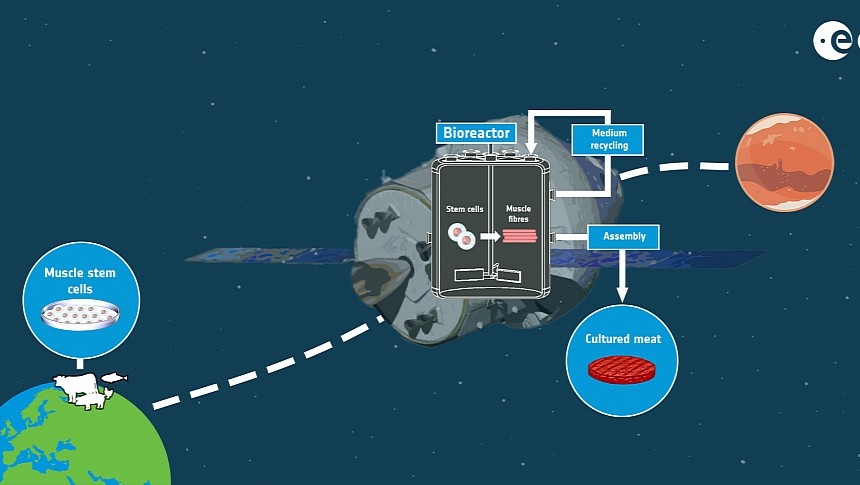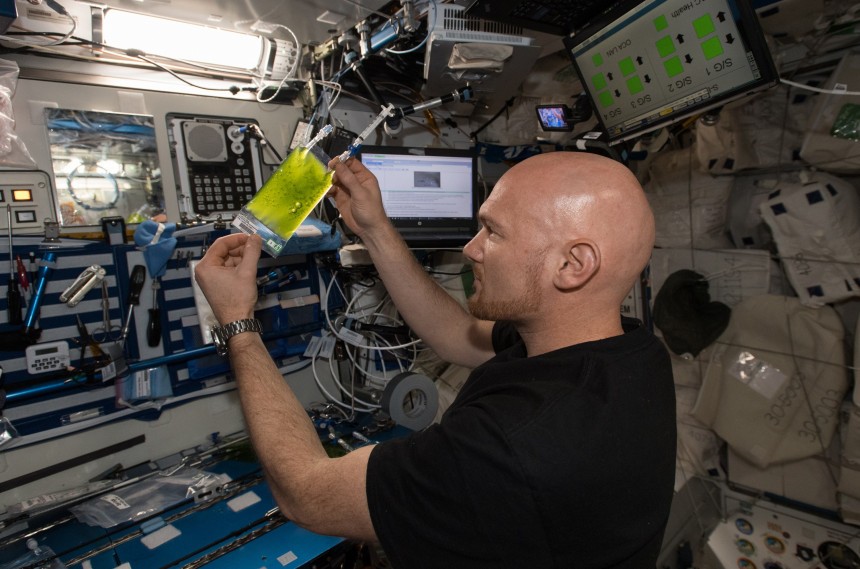Until now, the prospect of bringing fresh meat into space for astronauts to consume would been nothing short of laughable. Unless an extraordinary, ground-breaking innovation was made, any meat eaten by astronauts in space is either coming out of a metal tube or re-hydrated out of a bag. But cow-loving vegetarians rejoice! Not only does the ESA's plans for space-fairing cultivated meat not involve animal cruelty, but it's probably pretty darn tasty, too.
At its core, the basic principles of cultivated meat in space mirror that of the same practice here on Earth. Through the artificial cultivation of animal cells formed into a matrix similar to muscle fibers in meat-based protein, it can be made to mimic the texture and flavor of the real stuff far better than the awful black bean burgers at the average dive bar. The process is typically completed inside a hermetically-sealed bioreactor where an initial protein culture can multiply free from contaminants and bacteria that could hamper its growth. The end result, while not perfect, has serious potential for adaptation in deep space where resources are limited.
"The focus is to provide astronauts with nutritious food during long-term missions far from Earth, overcoming the typical two-year shelf-life of traditional packaged supplies." explained ESA engineer Paolo Corradi when discussing the fine details of sustaining a crew of humans in space for any extended period. "Given the limited resources in space, growing fresh food in situ would be necessary to increase the resilience and self-sufficiency of a mission and could also provide psychological support to the crew."
Indeed, the idea of in-situ protein cultivation being necessary for the long-term support and morale of any long-duration space mission speaks to the challenges of supplying enough freeze-dried food aboard a spacecraft where every last kilogram adds more headaches than the previous one. Engineers and scientists from Germany and Great Britain are hard at work in ESA research facilities trying to integrate protein bioreactors compact enough to fly on NASA/ESA spacecraft.
The benefits of something as tantalizing as fresh meat on long trips to the Moon and even Mars should be self-apparent when one remembers what astronauts have historically put in their bellies over the last 60 years. The first food consumed in space was two tubes of pureed beef and pork mixture and one tube of chocolate sauce on Yuri's two-ish hour space flight aboard the Vostok 1 spacecraft on April 12th, 1961. The practice of re-hydrating mush in a bag still permeates space travel today. Though not viable yet, this fledgling aspect of deep-space human sustainability is no doubt well worth the investment.
"It's something that is still in its infancy, so we proposed a roadmap that outlines the steps required to progress the necessary technologies and fill current knowledge gaps," Paolo Corradi added to her comments on in-situ cultivation in space. "This includes understanding how cells adapt to altered gravity and radiation," said João Garcia, ESA researcher in cultivated meat for space applications."By using facilities available at ESA, we will soon start experiments to understand these effects." As for what kind of timeline we could expect deployment for such technology, well, it's safe to say it won't be ready in time for Artemis III to land on the Moon.
But if memory foam is anything to go by, the impact of in-situ meat cultivation through stem cell research for deep space missions could trickle down to the commercial sector one day to supply us all with cruelty-free meat. Pork, chicken, and cattle cultivation contributes as much or more to the degradation of the Earth's atmosphere to pollution as automobiles or industrial manufacturing. While lab-made filet mignon at the dinner table is probably still decades away, small-scale operations fit to supply a handful of astronauts and nothing more might still be viable. Assuming the above-mentioned issues with zero-gravity and cosmic radiation can be addressed, that is.
"Hopefully, we will see soon the European Food Safety Authority granting similar approvals and the research rapidly progressing," continued Paolo, bringing to light the potential for more wide-scale commercial meat production as the ESA's research progresses. "The feeling is that we are at the beginning of a process that could transform the industry, making the conventional meat production model obsolete." As for what in-situ space meat might look like, it's hard to say this early into the research.
But per an Associated Press feature by Jonel Aleccia, artificially-cultivated chicken derrived from stem cells is purported to bear a taste "Richer than a chicken breast, more like the dark meat of a thigh. And the texture was both tender and chewy like a well-cooked chicken thigh should be." As far as culinary reviews go, that sounds like at least a passable experience. One can only imagine the flavor is even more divine in Martian orbit millions of miles away from the nearest steakhouse.
"The focus is to provide astronauts with nutritious food during long-term missions far from Earth, overcoming the typical two-year shelf-life of traditional packaged supplies." explained ESA engineer Paolo Corradi when discussing the fine details of sustaining a crew of humans in space for any extended period. "Given the limited resources in space, growing fresh food in situ would be necessary to increase the resilience and self-sufficiency of a mission and could also provide psychological support to the crew."
Indeed, the idea of in-situ protein cultivation being necessary for the long-term support and morale of any long-duration space mission speaks to the challenges of supplying enough freeze-dried food aboard a spacecraft where every last kilogram adds more headaches than the previous one. Engineers and scientists from Germany and Great Britain are hard at work in ESA research facilities trying to integrate protein bioreactors compact enough to fly on NASA/ESA spacecraft.
The benefits of something as tantalizing as fresh meat on long trips to the Moon and even Mars should be self-apparent when one remembers what astronauts have historically put in their bellies over the last 60 years. The first food consumed in space was two tubes of pureed beef and pork mixture and one tube of chocolate sauce on Yuri's two-ish hour space flight aboard the Vostok 1 spacecraft on April 12th, 1961. The practice of re-hydrating mush in a bag still permeates space travel today. Though not viable yet, this fledgling aspect of deep-space human sustainability is no doubt well worth the investment.
But if memory foam is anything to go by, the impact of in-situ meat cultivation through stem cell research for deep space missions could trickle down to the commercial sector one day to supply us all with cruelty-free meat. Pork, chicken, and cattle cultivation contributes as much or more to the degradation of the Earth's atmosphere to pollution as automobiles or industrial manufacturing. While lab-made filet mignon at the dinner table is probably still decades away, small-scale operations fit to supply a handful of astronauts and nothing more might still be viable. Assuming the above-mentioned issues with zero-gravity and cosmic radiation can be addressed, that is.
"Hopefully, we will see soon the European Food Safety Authority granting similar approvals and the research rapidly progressing," continued Paolo, bringing to light the potential for more wide-scale commercial meat production as the ESA's research progresses. "The feeling is that we are at the beginning of a process that could transform the industry, making the conventional meat production model obsolete." As for what in-situ space meat might look like, it's hard to say this early into the research.
But per an Associated Press feature by Jonel Aleccia, artificially-cultivated chicken derrived from stem cells is purported to bear a taste "Richer than a chicken breast, more like the dark meat of a thigh. And the texture was both tender and chewy like a well-cooked chicken thigh should be." As far as culinary reviews go, that sounds like at least a passable experience. One can only imagine the flavor is even more divine in Martian orbit millions of miles away from the nearest steakhouse.













